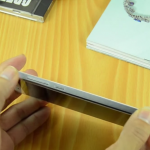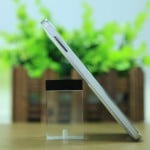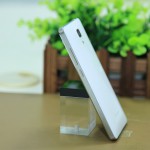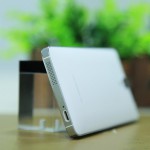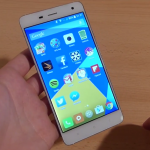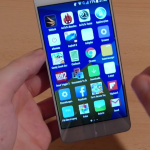If you love Xiaomi Mi4’s design but don’t want to spend over $350 on a phone, you have a few options in the Chinese market. Recently, we have seen almost five to six Xiaomi Mi4 clones from Chinese manufacturers like Doogee, Elephone, No.1, Zeaplus etc. These phones are an exact replica of the Mi4 except for the specifications and some of the features. But the best part is that most of these devices retail for less than $150, which is almost $200-$250 less than the original Xiaomi Mi4.
Today we look at the two hot Mi4 clones available to buy online, i.e. the No.1 Mi4 and the Doogee DG850. We have already reviewed these two phones in detail earlier, so you may want to check that out after you decide which one to buy among these two. Both the models feature a premium design much like the Xiaomi Mi4 even though it costs less than half its price and also comes with features that you don’t normally get in phones below $150.
With its solid built and customization options, both the models give tough competition to other rivals available in the market.
Since, most of the features of the two devices that we are comparing today are more or less the same, we know it would be hard to decide which one’s the best among these two. But still, when you have to make a purchase decision, its best to analyze the similarities and the differences between two models with utmost care.
No.1 Mi4 vs Doogee DG850
DESIGN
As both the models have taken inspiration from Xiaomi Mi4, you know exactly how they look. The front camera, speaker grill, rear camera and logo etc are all placed exactly as seen on the Mi4. In fact, both feature the glossy back panel found on the original model as well as the metal frame that makes the phone look much more premium than it actually is.
Since both models have exactly the same design, we’ll talk about it together. On top of the 5 inch display of both the devices is a sensor, ear piece and the front camera. Below the display lies the three capacitive keys, namely the menu, home and back. Surprisingly, these cheap Chinese manufacturers have successfully managed to minimize even the bezels on the phone. As you can see in the pictures given below, these phones feature very thin bezels, which makes it look even more solid and premium.
On the right side, you have the volume keys and the power button below it. The placement of these buttons are as comfortable as the original Mi4, especially since the power button lies near the middle which makes it easier to power on/ off the display while operating the 5 inch phone with just one hand. The rear panel features the same glossy plastic as seen on the Xiaomi flagship. You have the camera sensor at the top, followed by a single LED flash. One small difference that we saw between these two devices was that the Doogee model had a small company logo just below the LED flash, unlike the No.1 Mi4. However, other than that, both the models look exactly the same. In fact, you would never be able to distinguish between both the devices, had it not been for the company name printed at the bottom.
On the right lies the SIM card tray, while at the bottom, you have the speaker grill and the MicroUSB port used for charging. The placement of the speaker grill at the bottom is a very smart move since their output (even though its a single speaker grill) is much better than other phones which come with the speaker at the back. Once again, Mi4’s great design makes these phones stand out from the other rivals in this price range. Finally, on top, you have a 3.5mm headphone jack along with the IR blaster originally seen on the Xiaomi Mi4. So like we pointed out earlier, these phones even bring some of the special features of the Xiaomi flagship.
Both No.1 and Doogee have taken serious efforts to make their devices look like the Xiaomi Mi4. In fact, when we check the dimension of these devices, they are EXACTLY the same as the Xiaomi flagship.
Here are the dimension of the three phones under consideration:
No.1 Mi4 – 139.2 x 68.5 x 8.9mm
DOOGEE DG850 – 139.3 x 68.5 x 8.8mm
Xiaomi Mi4 – 139.2 x 68.5 x 8.9 mm
So if you ignore the company logos printed on the back, you won’t be able to differentiate between the three models based on their looks.
DISPLAY
Although the No.1 Mi4 and Doogee DG850 have a much smaller resolution display as compared to the Xiaomi Mi4, the difference isn’t that significant. We say this because, we didn’t expect these cheap clones to come with a decent display. However, for your everyday use, these 720p IPS panels are more than enough. They may not come with the FULL HD 1080p display like the Mi4 and you may even see some pixel on the screen, but we were pretty much satisfied with their overall quality. The images and the videos on the device were rich in colors and vibrant, which we feel is enough for your daily use.
Let me remind you that just a few years back, 720p resolution was the standard on most high end/ flagship smartphones. In fact, the mid range models came with qHD or 960 x 540 pixel resolution screens which looked good even with the large 4.7 inch displays that came with those phones.
So, a 1280 x 720 pixel resolution on a 5 inch phone which translates in a pixel density of 326PPI won’t look that bad as long as you don’t take them near a Quad HD 2K or a 1080p display.

Since both the models have exactly the same IPS panel with One Glass Solution (OGS), you get the same results from both the displays. The quality is good and viewing angles are decent, in short, you won’t be disappointed with both the models.
HARDWARE & PERFORMANCE
This is where the two Clones differ significantly from the Xiaomi Mi4 flagship. To start with, lets look at the specifications of the original Mi4. It comes with a Snapdragon 801 SoC clocked at 2.5GHz with Adreno 330 GPU.
On the other hand, the No.1 Mi4 comes with a Mediatek MT6582 Quad Core processor clocked at 1.3GHz. Even the Doogee DG850 features the same processor, which actually isn’t that surprising given that most budget phones, even the ones below $100 (that we covered recently in this article) came with the same Quad Core Mediatek processor.
However, from the Mediatek phones that we have tested recently, this MT6582 Quad core SoC isn’t bad at all. It may not pack the punch as a 2.5Ghz Quad Core Snapdragon 801 processor, but it performs well even when we threw a lot of heavy apps and games at it. On both the devices, gaming was excellent. Games like Asphalt 8 ran pretty smoothly on these devices, with the No.1 Mi4 experiencing the least amount of lag.
You get 1GB RAM on both the devices, which you may feel is a bit less. While most of the times you won’t experience any lag, these cheap clones does struggle to multi-task. Its not really the fault of the processor, but of the 1GB RAM module, which doesn’t allow more than 2-3 apps to run simultaneously.
Inside, you get 16GB storage which unfortunately is not expandable. As a result, you may not have enough storage to save all your favorite songs,videos and images on both the devices.
Given that they have the same internals, the performance is almost the same. We did feel that the No.1 Mi4 struggled a bit more than the Doogee model, especially when you tried powering on the display. The phone took around a second more to power on when compared to the Doogee model. But that’s just a minor issue and hence, we feel both perform well enough for your everyday usage.
| No.1 Mi4 | Doogee DG850 Hitman | |
| Display | 5 inch 720p (326PPI) | 5 inch 720p (326PPI) |
| Processor | 1.3GHz MediaTek MT6582 quad-core chipset | 1.3GHz MediaTek MT6582 quad-core chipset |
| Memory | 1GB RAM + 16GB Internal storage (MicroSD: NO) | 1GB RAM + 16GB Internal storage (MicroSD: NO) |
| Cameras | REAR: 13MP(8MP interpolated) | REAR: 13MP(8MP interpolated) |
| FRONT: 8MP (5MP interpolated) | FRONT: 8MP (5MP interpolated) | |
| Battery | 2,250 mAh | 2,500 mAh |
| Size | 139.2 x 68.5 x 8.9mm | 139.3 x 68.5 x 8.8mm |
| OS | Android 4.4 Kitkat + MIUI Launcher | Android 4.4 Kitkat |
| Price | $139.99 | $144 |
CAMERA
Camera is yet another category where Xiaomi Mi4 is miles ahead of these two clones. But you may be wondering why, especially when all the three models claim to come with a 13MP sensor.
Xiaomi was right in saying that the Mi4 featured a 13MP camera sensor, however for both the other clones, the 13MP that the company claim is inside their phones is actually only 8MP sensors. This is because the MT6582 chipset that power these devices can support only camera sensors of up to 8MP. But then these companies are not lying also as in the end, the pictures captured do have a 13MP resolution. So, how do they achieve this feat?
Well, both the devices have 8MP sensors which use software interpolation techniques to create an image with a 13MP end resolution. This of course is not as good as the real 13MP sensor found on the Mi4, but it is still good enough for capturing decent pictures in well lit conditions.
Color reproduction was especially good on the No.1 Mi4 and noise was minimum. We were especially impressed by the device’s Night Mode, which brought in a lot of light when shooting indoors.
Doogee DG850 too comes with a decent camera, but its not as good as the No.1 model. Noise was prevalent in most images, especially when the lights were a bit dim. Low light performance is also not as good as the No.1 Mi4. So, its no surprise that we like the No.1 model better.
On the front, you have an 8MP sensor on both the models, which clicked decent selfies.
BATTERY
Another difference between these two models is their battery. The Doogee DG850 Hitman model came with a larger 2,500mAh Lithium-ion Polymer battery as compared to the 2,250mAh capacity one found on the No.1 Mi4. This does create a slight difference in the talktimes, but its not as significant as you may think.
While we didn’t get the time to test both the batteries thoroughly, from the initial tests, they lasted throughout the day with moderate usage pretty easily. This could be due to the power efficient quad core MT6582 processor inside.
However, don’t expect extra-ordinary results with this battery pack. If you were to play graphic intensive games or even HD videos on the device, the battery would drop rapidly and you would soon have to find a power outlet for your device. But for moderate use, which is how these devices are meant to be used, the 2500mAh and 2250mAh batteries on DG850 and No.1 Mi4 should be more than enough.
So, we would say the battery life on both the models is around the same as other phones in this price range.
SOFTWARE & CONNECTIVITY
Both the models come with Android 4.4 Kikat OS out of the box, however the No.1 Mi4 runs MIUI launcher on top. This brings a lot of customization and visual options that you don’t normally get in a traditional Android UI. MIUI 5.0 is one of the best custom OS built on the Android platform and its good to see that you get this rich UI on a cheap phone like the No.1 Mi4. The settings, notifications panel and camera UI are more or less identical to MIUI in both the devices.
Coming to the Doogee DG850, it comes with a traditional Android 4.4.2 KitKat OS out of the box with a little Doogee customized UI on top. If you have ever used or seen Doogee smartphones in the past, then you know exactly how it looks. The icons are not stock Android but customized by Doogee and there are some additional features like wake gestures, air shuffle and remote apps in additional to the full list of Google apps that comes pre-installed.
Let me remind you, unlike most Chinese smartphones in the market, the No.1 Mi4 comes with just ONE SIM CARD SLOT. On the other hand, the DG580 has a DUAL SIM CARD slot. So, the lack of a second SIM card option may affect your purchase decision.
Other connectivity options are more or less the same. So you have Wi-Fi b/g/n, Bluetooth 4.0, GPS/ AGPS, FM Radio, Compass, IR Blaster and a bunch of sensor on both the devices. You can also wake up the screen with double tap in these clones.
The No.1 Mi4 comes with a Wireless Display feature which allows you to connect your smartphone to an HDTV using the in-house Wi-Fi. All you have to do is turn on the Wireless Display feature and pair your HDTV. Once paired, your phone will project everything that is on its screen on to the large screen TV. This feature is particularly useful when you have to show some high resolution pictures or videos to a large audience such as in a family gathering. Even playing games is made possible with this innovative feature.
There are a lot of gesture features also available on both the devices. For example in the DG850 model, you can draw characters on the screen which is turned off to directly open up a selected app. So, when you draw I on the screen, the phone will open up the camera. Similarly, M will open up music player and there are many other letters which open specific apps. Luckily, Doogee allows you to edit these assigned letters with your favorite apps, so that the shortcut helps you to access your most favorite apps instantly.
VERDICT
It wasn’t an easy decision to pick out a winner in the No.1 Mi4 vs Doogee DG850 comparison because of their vast similarities. But we managed to find out a few differences. While the DG850 was slightly better when it came to the battery life, the camera performance and the Software features on the No.1 Mi4 was much better than the former. This is why we decided to go with the No.1 Mi4 in this comparison.
Moreover, Doogee announced their DG850 device much before it even went into production. As a result, customers had to wait almost two months to get their hands on the device. If they would have released it a few weeks earlier, you could have easily got the device much before Christmas holidays making it a great gift to your friend or family.
On the other hand, No.1 managed to release their device just a few weeks after the announcement. They announced it around late November, and you can already purchase it from leading online stores. Also, we feel the No.1 model offers much more features and customization options than most other smartphones in this price range, which is why we No.1 Mi4 comes out as the winner.
Also with the available coupons, the No.1 Mi4 is much cheaper than the DG850. Which is another reason to buy this new device.
Usually you have to pay more than $170 for the phone but now, you can get the No.1 Mi4 from GearBest for $139.99. If you like the Doogee DG850 Hitman model, you can get that too for around $150 from GearBest.
Buy No.1 Mi4 for just $139.99Buy Doogee DG850 for 129.99
[socialpoll id=”2236085″]





